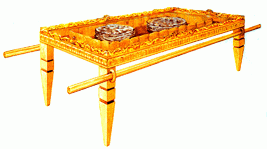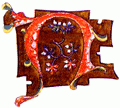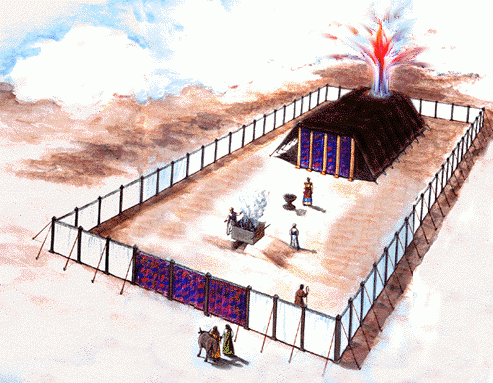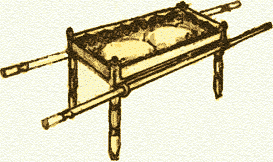1599 Geneva Bible (GNV)
The Geneva Bible: A Cornerstone of English Protestantism A Testament to Reform The 1599 Geneva Bible... Read More

It was also called the Table of the Presence.

Now we will pass through the door of the tabernacle and enter the holy place. The priest had at his right hand the table of shewbread or also referred to as the table of the presence. It was made of acacia wood overlaid with pure gold. Its size was 2 cubits (3 feet) in length by one cubit (1 1/2 feet) in breadth and a height of 1 1/2 cubits (2 1/4 feet). Around the table was a border of gold and then a little further in, on the table top, an additional border which would hold the contents in place. The table had four legs, and two gold plated poles were inserted through golden rings attached to the legs for transporting.
Exod 25:23-30 "You shall also make a table of acacia wood; two cubits shall be its length, a cubit its width, and a cubit and a half its height. And you shall overlay it with pure gold, and make a molding of gold all around. You shall make for it a frame of a handbreadth all around, and you shall make a gold molding for the frame all around. And you shall make for it four rings of gold, and put the rings on the four corners that are at its four legs. The rings shall be close to the frame, as holders for the poles to bear the table. And you shall make the poles of acacia wood, and overlay them with gold, that the table may be carried with them. You shall make its dishes, its pans, its pitchers, and its bowls for pouring. You shall make them of pure gold. And you shall set the showbread on the table before Me always."
The purpose of the golden table was to hold 12 cakes of bread made of fine flour. They were placed there in two rows of six, each loaf representing one of the tribes of Israel (Lev. 24:8).
Lev 24:5-9 "And you shall take fine flour and bake twelve cakes with it. Two-tenths of an ephah shall be in each cake. You shall set them in two rows, six in a row, on the pure gold table before the LORD. And you shall put pure frankincense on each row, that it may be on the bread for a memorial, an offering made by fire to the LORD. Every Sabbath he shall set it in order before the LORD continually, being taken from the children of Israel by an everlasting covenant. And it shall be for Aaron and his sons, and they shall eat it in a holy place; for it is most holy to him from the offerings of the LORD made by fire, by a perpetual statute."
The historian Josephus indicates that the bread was unleavened. This bread is sometimes referred to as being the 'shewbread' because its literal meaning is 'bread of the face', i.e. bread set out before the face or presence of God.

This is the first mention of the word "table" (communion & fellowship) in the Bible. (comment)

The Table
-It was made of acacia wood overlaid with gold.
-It was 2 cubits long, 1 cubit wide and 1 1/2 cubits high. (the ark was the same height).
-It had a gold molding (crown) all around.
-The molding was the width of a hand (to secure the bread)
-It had a gold ring at each corner leg for the staves (wood overlaid with gold).
The Four vessels
-There were 4 vessels of pure gold on the table with the bread:
Dishes (breadplates)
Pans or Spoons (to sprinkle frankincense)
Pitchers (for liquid offerings)
Bowls (vessels containing the frankincense)

Each of the 12 cakes represented one of the tribes of Israel.
-The tables purpose was to show the bread, which were 12 small, flat, round loaves that were laid out in an orderly fashion so as to be displayed.
Lev 24:5-6 "And you shall take fine flour and bake twelve cakes with it. Two-tenths of an ephah shall be in each cake. "You shall set them in two rows, six in a row, on the pure gold table before the LORD.
Lev 24:7 "And you shall put pure frankincense on each row, that it may be on the bread for a memorial, an offering made by fire to the LORD.
Lev 24:8-9 "Every Sabbath he shall set it in order before the LORD continually, being taken from the children of Israel by an everlasting covenant. And it shall be for Aaron and his sons, and they shall eat it in a holy place; for it is most holy to him from the offerings of the LORD made by fire, by a perpetual statute."
-Every seventh (Sabbath) day, fresh hot loaves were provided by Aaron. The priests were entitled to eat the old loaves while standing in the Holy Place.
-The frankincense that was removed each week was as a special oblation (offering) to God.
-12 loaves were the same material, size, and weight (no partiality).
-According to Lev 22, if a priest was unclean he couldn't eat of the shewbread. No layman, or daughter married to a layman, or a hired servant could eat of the shewbread. But a purchased slave or those born in his house could.
-According to tradition 8 priests held hands as they changed the bread, and passed it for fellowship.
-They were to be holy because of the bread
Lev 21:6 `They shall be holy to their God and not profane the name of their God, for they offer the offerings of the LORD made by fire, and the bread of their God; therefore they shall be holy.
No Sitting Down
For although the bread was on a table, no priest could ever be seated at that table or anywhere else in the tabernacle. Priests always stood while they carried out their duties. There was no place to be seated, no provision for rest in this pattern of worship and no suggestion that their task was ever completed.
Heb 10:11-14 "And every priest stands ministering daily and offering repeatedly the same sacrifices, which can never take away sins. But this Man, after He had offered one sacrifice for sins forever, sat down at the right hand of God, from that time waiting till His enemies are made His footstool. For by one offering He has perfected forever those who are being sanctified."
Journeying
Num 4:5-8 "When the camp prepares to journey, Aaron and his sons shall come, and they shall take down the covering veil and cover the ark of the Testimony with it. Then they shall put on it a covering of badger skins, and spread over that a cloth entirely of blue; and they shall insert its poles. On the table of the Presence they shall spread a blue cloth, and put on it the dishes, the pans, the bowls, and the pitchers for pouring; and the showbread shall be on it. They shall spread over them a scarlet cloth, and cover the same with a covering of badger skins; and they shall insert its poles."

A Type of Christ
The table of shewbread was referred to as the table of the Presence. Gods light forever shines on His people. The 12 baked cakes of bread spoke of Gods people who were one with Him as the priests joined together for the fellowship of eating the bread and becoming one. Jesus referred to Himself as the bread of life and said if we eat this bread we will live forever. The very nature of bread is to provide physical sustenance and as you eat the bread and digest it, it becomes part of you. The very nature of the Word of God is to provide spiritual sustenance and as it is received it becomes part of our very nature. Just as the table always speaks of fellowship and communion, so the table of the shewbread points to Jesus who has made a covenant built on better promises and provided a blood covenant meal for us to partake that we might all be one in the Spirit.
John 6:35 And Jesus said to them, "I am the bread of life. He who comes to Me shall never hunger, and he who believes in Me shall never thirst."
Jn 6:51-58 "I am the living bread which came down from heaven. If anyone eats of this bread, he will live forever; and the bread that I shall give is My flesh, which I shall give for the life of the world. As the living Father sent Me, and I live because of the Father, so he who feeds on Me will live because of Me. This is the bread which came down from heaven-- not as your fathers ate the manna, and are dead. He who eats this bread will live forever."
Jn 6:63 "It is the Spirit who gives life; the flesh profits nothing. The words that I speak to you are spirit, and they are life."
Only in the work of Christ as great high priest on behalf of his people was the work ever finished. His sacrifice was fully effective and was a completed work. No priest could ever be seated but after his great cry, 'It is finished', Jesus Christ left the altar of Calvary and sat down at the right hand of God.


Jesus said, "I am the bread of life."
The Geneva Bible: A Cornerstone of English Protestantism A Testament to Reform The 1599 Geneva Bible... Read More
The 21st Century King James Version (KJ21): A Modern Approach to a Classic Text A Balancing Act The ... Read More
The American Standard Version (ASV): A Cornerstone of Modern English Bibles A Product of Scholarly R... Read More
The Amplified Bible (AMP): A Rich and Comprehensive Translation The Amplified Bible (AMP) stands out... Read More
The Amplified Bible, Classic Edition (AMPC): A Timeless Treasure The Amplified Bible, Classic Editio... Read More
The Authorized (King James) Version (AKJV): A Timeless Classic The Authorized King James Version (AK... Read More
The BRG Bible: A Colorful Approach to Scripture A Unique Visual Experience The BRG Bible, an acronym... Read More
The Christian Standard Bible (CSB): A Balance of Accuracy and Readability The Christian Standard Bib... Read More
The Common English Bible (CEB): A Translation for Everyone The Common English Bible (CEB) is a conte... Read More
The Complete Jewish Bible (CJB): A Jewish Perspective on Scripture The Complete Jewish Bible (CJB) i... Read More
The Contemporary English Version (CEV): A Bible for Everyone The Contemporary English Version (CEV),... Read More
The Darby Translation: A Literal Approach to Scripture The Darby Translation, often referred to as t... Read More
The Disciples' Literal New Testament (DLNT): A Window into the Apostolic Mind The Disciples’ Literal... Read More
The Douay-Rheims 1899 American Edition (DRA): A Cornerstone of English Catholicism The Douay-Rheims ... Read More
The Easy-to-Read Version (ERV): A Bible for Everyone The Easy-to-Read Version (ERV) is a modern Engl... Read More
The English Standard Version (ESV): A Modern Classic The English Standard Version (ESV) is a contemp... Read More
The English Standard Version Anglicised (ESVUK): A British Accent on Scripture The English Standard ... Read More
The Evangelical Heritage Version (EHV): A Lutheran Perspective The Evangelical Heritage Version (EHV... Read More
The Expanded Bible (EXB): A Study Bible in Text Form The Expanded Bible (EXB) is a unique translatio... Read More
GOD'S WORD Translation (GW): A Modern Approach to Scripture The GOD'S WORD Translation (GW) is a con... Read More
The Good News Translation (GNT): A Bible for Everyone The Good News Translation (GNT), formerly know... Read More
The Holman Christian Standard Bible (HCSB): A Balance of Accuracy and Readability The Holman Christi... Read More
The International Children's Bible (ICB): A Gateway to Faith The International Children's Bible (ICB... Read More
The International Standard Version (ISV): A Modern Approach to Scripture The International Standard ... Read More
The J.B. Phillips New Testament: A Modern Classic The J.B. Phillips New Testament, often referred to... Read More
The Jubilee Bible 2000 (JUB): A Unique Approach to Translation The Jubilee Bible 2000 (JUB) is a dis... Read More
The King James Version (KJV): A Timeless Classic The King James Version (KJV), also known as the Aut... Read More
The Lexham English Bible (LEB): A Transparent Approach to Translation The Lexham English Bible (LEB)... Read More
The Living Bible (TLB): A Paraphrase for Modern Readers The Living Bible (TLB) is a unique rendering... Read More
The Modern English Version (MEV): A Contemporary Take on Tradition The Modern English Version (MEV) ... Read More
The Mounce Reverse Interlinear New Testament: A Bridge to the Greek The Mounce Reverse Interlinear N... Read More
The Names of God Bible (NOG): A Unique Approach to Scripture The Names of God Bible (NOG) is a disti... Read More
The New American Bible, Revised Edition (NABRE): A Cornerstone of English Catholicism The New Americ... Read More
The New American Standard Bible (NASB): A Cornerstone of Literal Translations The New American Stand... Read More
The New American Standard Bible 1995 (NASB1995): A Refined Classic The New American Standard Bible 1... Read More
The New Catholic Bible (NCB): A Modern Translation for a New Generation The New Catholic Bible (NCB)... Read More
The New Century Version (NCV): A Bible for Everyone The New Century Version (NCV) is an English tran... Read More
The New English Translation (NET): A Transparent Approach to Scripture The New English Translation (... Read More
The New International Reader's Version (NIRV): A Bible for Everyone The New International Reader's V... Read More
The New International Version - UK (NIVUK): A British Accent on Scripture The New International Vers... Read More
The New International Version (NIV): A Modern Classic The New International Version (NIV) is one of ... Read More
The New King James Version (NKJV): A Modern Update of a Classic The New King James Version (NKJV) is... Read More
The New Life Version (NLV): A Bible for All The New Life Version (NLV) is a unique English translati... Read More
The New Living Translation (NLT): A Modern Approach to Scripture The New Living Translation (NLT) is... Read More
The New Matthew Bible (NMB): A Reformation Revival The New Matthew Bible (NMB) is a unique project t... Read More
The New Revised Standard Version (NRSV): A Modern Classic The New Revised Standard Version (NRSV) is... Read More
The New Revised Standard Version Catholic Edition (NRSVCE): A Cornerstone of Modern Catholicism The ... Read More
The New Revised Standard Version, Anglicised (NRSVA): A British Accent on Scripture The New Revised ... Read More
The New Revised Standard Version, Anglicised Catholic Edition (NRSVACE): A Bridge Between Tradition ... Read More
The New Testament for Everyone (NTE): A Fresh Perspective The New Testament for Everyone (NTE) is a ... Read More
The Orthodox Jewish Bible (OJB): A Unique Perspective The Orthodox Jewish Bible (OJB) is a distincti... Read More
The Revised Geneva Translation (RGT): A Return to the Roots The Revised Geneva Translation (RGT) is ... Read More
The Revised Standard Version (RSV): A Cornerstone of Modern English Bibles The Revised Standard Vers... Read More
The Revised Standard Version Catholic Edition (RSVCE): A Cornerstone of English Catholicism The Revi... Read More
The Message (MSG): A Contemporary Paraphrase The Message, often abbreviated as MSG, is a contemporar... Read More
The Voice: A Fresh Perspective on Scripture The Voice is a contemporary English translation of the B... Read More
The Tree of Life Version (TLV): A Messianic Jewish Perspective The Tree of Life Version (TLV) is a u... Read More
The World English Bible (WEB): A Modern Update on a Classic The World English Bible (WEB) is a conte... Read More
The Worldwide English (WE) New Testament: A Modern Take on a Classic The Worldwide English (WE) New ... Read More
The Wycliffe Bible: A Cornerstone of English Scripture A Revolutionary Translation The Wycliffe Bibl... Read More
Young's Literal Translation (YLT): A Literal Approach to Scripture Young's Literal Translation (YLT)... Read More
Deuteronomy 18 - "And if you say in your heart, 'How shall we know the word which the LORD has not ... Read More
John 14:26 - "But the Counselor, the Holy Spirit, whom the Father will send in my name, he will teac... Read More
(Enlarge) (PDF for Print) Map of the Origin of Nations and Races that were dispersed by God in Gene... Read More
The Journeys of Abraham (Enlarge) (PDF for Print) - Map of Abraham's Journey with Trade Routes Map ... Read More
(Enlarge) (PDF for Print) Map of the Route of the Hebrews from Egypt This map shows the Exodus of t... Read More
Mark 6:52 - For they considered not the miracle of the loaves: for their heart was hardened. God did... Read More
also see:The Encampment of the Children of IsraelThe Children of Israel on the March THE OUTER COURT... Read More
2 Chronicles 36:23 - Thus saith Cyrus king of Persia, All the kingdoms of the earth hath the LORD Go... Read More
All Bible Maps - Complete and growing list of Bible History Online Bible Maps. Old Testament Maps T... Read More
The Bible portrays marriage as a lifelong bond built on love, faith, and commitment, reflecting God'... Read More
Ancient Manners and Customs, Daily Life, Cultures, Bible Lands NINEVEH was the famous capital of an... Read More
Distances From Jerusalem to: Bethany - 2 milesBethlehem - 6 milesBethphage - 1 mileCaesarea - 57 m... Read More
Dagon was the god of the Philistines. This image shows that the idol was represented in the combina... Read More
Map of Israel in the Time of Jesus (Enlarge) (PDF for Print) Map of First Century Israel with Roads... Read More
The Table of Shewbread (Ex 25:23-30) It was also called the Table of the Presence. Now we will pas... Read More
see also:The PriestThe Consecration of the PriestsThe Priestly Garments The Priestly Garments 'The ... Read More
Introduction to the Book of Daniel in the Bible Daniel 6:15-16 - Then these men assembled unto the k... Read More
The Golden Lampstand was hammered from one piece of gold. Exod 25:31-40 "You shall also make a lam... Read More
The Golden Altar of Incense (Ex 30:1-10) The Golden Altar of Incense was 2 cubits tall.It was 1 cub... Read More
Ancient Tax Collector Illustration of a Tax Collector collecting taxes Tax collectors were very des... Read More
also see: Blood Atonement and The Priests The Five Levitical Offerings The Sacrifices The sacrificia... Read More
Genesis 10:32 - These are the families of the sons of Noah, after their generations, in their nation... Read More
Illustration of Jesus Reading from the Book of Isaiah This sketch contains a colored illustration o... Read More
"But the angel said unto him, Fear not, Zacharias: for thy prayer is heard; and thy wife Elisabeth s... Read More
also see: The Encampment of the Children of IsraelThe Children of Israel on the March The brazen a... Read More
In a rapidly evolving world shaped by both timeless values and groundbreaking technology, individual... Read More
Unearth the rich tapestry of biblical history with our extensive collection of over 1000 meticulously curated Bible Maps and Images. Enhance your understanding of scripture and embark on a journey through the lands and events of the Bible.
Start Your Journey Today!
